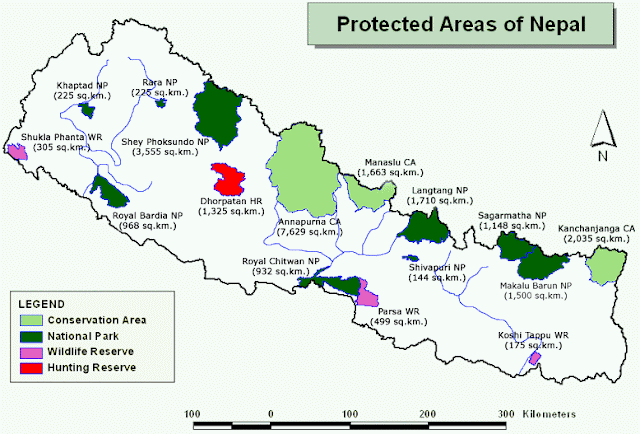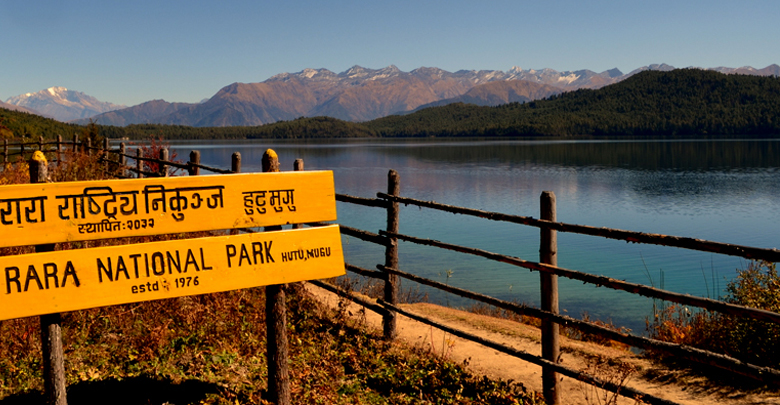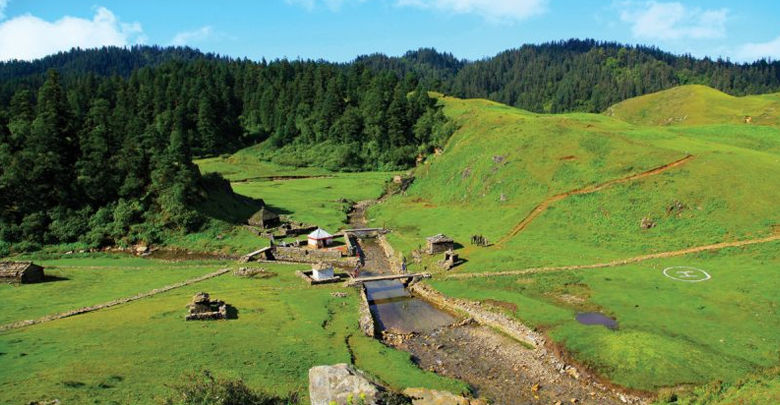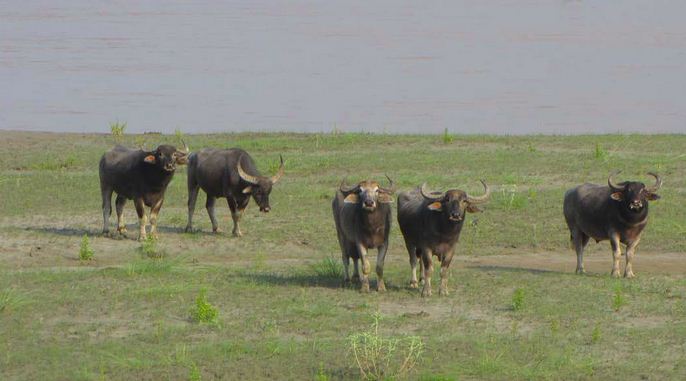 National Parks of Nepal.
National Parks of Nepal.Nepal serves as one of the best collection of wild life on the planet - From exotic Lophophorus to the elusive Royal Bengali Tiger, and from the endangered One-Horned Rhino to exotic Snow leopard. These are only few to mention as it also has the largest collection of birds and butterflies in the world. Even in an small area of less than 100,000 sq. miles, Nepal not just have the elevation of 70 m to 8,848 m; but a wide variety of wild floras and faunas that is incomparable with any other geographic Nation of the world.The government has included following sites as the official Nation Parks of Nepal.

1.ROYAL CHITWAN NATIONAL PARK
AREA (932 SQ. KMS.)
Location. Royal Chitwan National Park, the oldest national park in Nepal, is situated in the subtropical inner Terai lowlands of South-Central Nepal. The park was designated as a World Heritage Site in 1984.
Features. The park covers a pristine area with a unique ecosystem of significant value to the world. It contains the Churiya hills, ox-bow lakes and flood plains of Rapti, Reu and Narayani Rivers. Approximately 70% of the park vegetation is sal forest. The remaining vegetation types include grassland (20%), riverine forest (7%), and sal with chirpine (3%), the latter occurring at the top of the Churiya range. The riverine forests consist mainly of khair, sissoo and simal. The grassland forms a diverse and complex community with over 50 species. The Saccharun species, often called elephant grass, can reach 8 m. in height. The shorter grasses such as Imperata are useful for thatch roofs.
There are more than 43 species of mammals in the park. The park is especially renowned for the endangered one-horned rhinoceros, the tiger and the gharial crocodile along with many other common species such as gaur, wild elephant, four-horned antelope, striped hyena, pangolin, Gangetic dolphin, monitor lizard and python. Other animals found in the park include the sambar, chital, hog deer, barking deer, sloth bear, palm civet, langur and rhesus monkey.
Ther are over 450 species of birds in the park. Among the endangered birds are the Bengal florican, giant hombill, lesser florican, black stork and white stork. Common birds seen in the park include the peafowl, red jungle fowl, and different species of egrets, herons, kingfishers, flycatchers and woodpeckers. The best time for bird watching is March and December. More than 45 species of amphibians and reptiles occur in the park, some of which are the marsh crocodile, cobra, green pit viper and various species of frogs and tortoises.
The park is actively engaged in the scientific studies of several species of wild fauna and flora.

2.SAGARMATHA NATIONAL PARK
AREA (1.148 SQ. KMS.)
Location. Sagarmatha National Park is located to the north-east of Kathmandu in the Khumbu region of Nepal. The park includes the highest peak in the world, Mt. Sagarmatha (Everest), and several other well-known peaks such as Lhotse, Nuptse, Cho Oyu, Pumori, Ama Dablam, Thamserku, Kwangde, Kangtaiga and Gyachung Kang. The park was added to the list of World Heritage Sites in 1979.
Features. The mountains of Sagarmatha National Park are geologically young and broken up by deep gorges and glacial valleys. Vegetation includes pine and hemlock forests at lower altitudes, fir, juniper, birch and rhododendron woods, scrub and alpine plant communities, and bare rock and snow. The famed bloom of rhododendrons occurs during spring (April and May) although other flora is most colorful during the monsoon season (June to August).
Wild animals most likely to be seen in the park are the Himalayan tahr, goral, serow and musk deer. The snow leopard and Himalayan black bear are present but rarely sighted. Other mammals rarely seen are the weasel, marten, Himalayan mouse hare (pika), jackal and langur monkey.
The park is populated by approximately 3,000 of the famed Sherpa people whose lives are interwoven with tlle teachings of Buddhism. The main settlements are Namohe Bazar, Khumjung, Khunde, Thame, Thyang boche, Pangboche and Phortse. The economy of the Khumbu Sherpa corn munity has traditionally been heavily based on trade and livestock herding. But with the coming of international mountaineering expeditions since 1950 and the influx of foreign trekkers, the Sherpa economy today is becoming increasingly dependent on tourism.

3.LANGTANG NATIONAL PARK
AREA (1,710 SQ. KMS.)
Location. Situated in the Central Himalaya, Langtang is the nearest park from Kathmandu. The area extends from 32 km north of Kathmandu to the Nepal-China (Tibet) border.
Features. Langtang National Park encloses the catchments of two major river systems: one draining west into the Trisuli River and the other east to the Sun Koshi river.
Some of the best examples of graded climate conditions in the Central Himalaya are found here. The complex topography and geography together with the varied climatic patterns have enabled a wide spectrum of vegetation type to be established. These include small areas of subtropical forest (below 1000 m), temperate oak and pine forests at mid-elevation, with alpine scrub and grasses giving way to bare rocks and snow.
Oaks, chir pine, maple, fir, blue pine, hemlock, spruce and various species of rhododendron make up the main forest species.
Along with the existing forest cover, approx. 25% of the total area provides habitat for a wide range of animals including wild dog, red panda, pika, muntjack, musk deer, Himalayan black bear, Himalayan tahr, ghoral, serow, rhesus monkey and common langur. The Trisuli-Bhote Koshi forms an important route for birds on spring and autumn migration between India and Tibet.
About 45 villagse (846 households=ca. 4500 people) are situated within the park boundaries, but they are not under park jurisdiction. In total, about 3000 households (ca. 16,200 people) depend on the park resources for wood and firewood. Culturally the area is mixed, the home of several ethnic groups which have influenced the natural enviroment over the centuries.

4.ROYAL BARDIYA NATIONAL PARK
AREA (968 SQ. KMS.)
Location. Royal Bardiya National Park is situated in the mid far western Terai, east of the Karnali River.
Features. The park is the largest and most undisturbed wildreness area in the Terai. About 70% of the park is covered with dominantly sal forest with the balance a mixture of grassland, savannah and riverine forest. The approximately 1500 people who used to live in this valley have been resettled elsewhere. Since farming has ceased in the Babai Valley, natural vegetation 15 regenerating, making it an area of prime habitat for wildlife.The park provides excellent habitat for endangered animals like the rhinoceros, wild elephant, tiger, swamp deer, black buck, gharial crocodile, marsh mugger crocodile and Gangetic dolphin. Endangered birds include the Bengal florican, lesser florican, silver-eared mesia and Sarus crane. More than 30 different mammals, over 200 species of birds, and many snakes, lizards and fish have been recorded in the park's forest, grassland and river habitats. A good number of resident and migratory birds are found in the park

5.SHEY-PHOKSUNDO NATIONAL PARK
AREA (3,555 SQ. KMS.)
Location. Shey-Phoksundo National Park is situated in the mountain region of western Nepal, covering parts of Dolpa and Mugu Districts. It is the largest national park in the country.
Features. The park contains luxuriant forests, mainly comprised of blue pine, spruce, cypress, poplar, deodar, fir and birch. The Jugdula River valley consists mostly of Quercus species. The trans-Himalayan area has a near-desert type vegetation of mainly dwarf juniper and caragana shrubs.The park provides prime habitat for the snow leopard and the blue sheep. Other common animals found in the park are ghoral, Himalayan tahr, serow, leopard, wolf, jackal, Himalayan black bear, Himalayan weasel, Himalayan mouse hare, yellow-throated marten, langur and rhesus monkeys.The park is equally rich in many species of birds, such as the Impeyan pheasant (danphe), blood pheasant, cheer pheasants, red and yellow billed cough, raven, jungle crow, snow partridge and many others.

6.RARA NATIONAL PARK
AREA (106 SQ. KMS.)
Location. Rara National Park is located in north-west Nepal about 371 km air distance from Kathmandu. Most of the park, including Lake Rara, lies in Mugu District; a small area is within Jumla District of Karnali Zone. This is the smallest park in Nepal, containing the country's biggest lake (10.8 sq kms) at an elevation of 2990 m.
Features. Park elevations range from 1800 m to 4048 m. The park contains mainly coniferous forest. The area around the lake is dominated by blue pine, black juniper, West Himalayan spruce, oak, Himalayan cypress and other associated species. At about 3350 rn, pine and spruce give way to fir, oak and birch. Deciduous tree species like Indian horse-chestnut, walnut and Himalayan popular are also found. A small portion of the park serves as an ideal habitat for musk deer. Other animals found in the park include Himalayan black bear, leopard, ghoral, Himalayan tahr and wild boar. Snow trout is the only fish species recorded in the lake. Resident Gallinaceous birds and migrant waterfowl are of interest to park visitors. The great-crested grebe, black-necked grebe, and red-crested pochard are seen during winter. Other common birds are the snowcock, chukor partridge, Impeyan pheasant, kalij pheasant and blood pheasant.

7.KHAPTAD NATIONAL PARK
AREA(225SQ.KMS.)
Location. The Khaptad National Park is a protected area in the Far-Western Region, Nepal that was established in 1984. Stretching over the four districts of Bajhang, Bajura, Achham and Doti it covers an area of 225 km2 (87 sq mi) and ranges in elevation from 1,400 m (4,600 ft) to 3,300 m (10,800 ft).
Features. Khaptad National Park was established in 1984 on the advice of the region’s holy man Khaptad Baba. The renowned Khaptad Baba Ashram, a religious site where Hindu pilgrims come to worship Shiva on the full moon of July–August each year, is located near the park headquarters. Current checklists include 23 mammals, 287 birds, and 23 amphibians and reptiles. Mammal species symbolic of the park are leopard, Himalayan black bear, wild dog, and musk deer. Bird species symbolic of the park include the impeyan pheasant, peregrine falcon, and white-rumped vulture. The landscape consists of moorland, steep slopes, and streams. 567 species of flora have been recorded in the protected area. Vegetation types include chir pine-rhododendron forest, oak forest and Himalayan fir-hemlock-oak forest and alder forest in riverine areas

8.MAKALU BARUN NATIONAL PARK
AREA(1500SQ.KMS)
lOCATION.The Makalu Barun National Park is the eighth national park in the Himalayas of Nepal and was established in 1992 as eastern extension of the Sagarmatha National Park. Covering an area of 1,500 km2 (580 sq mi) in the districts of Solukhumbu and Sankhuwasabha it is the world's only protected area with an elevation gain of more than 8,000 m (26,000 ft) enclosing tropical forest as well as snow-capped peaks. The bufferzone adjacent to the park's southern and southeastern border covers an area of 830 km2 (320 sq mi)
Features. This stunning, and remote national park is a true national marvel. Visitors are dwarfed by the mountainous skyline which is home to some of the world’s largest mountains. Mount Makalu (8,463 meters or 27,838 feet), the parks namesake, is the fifth highest mountain in the world while many of its neighboring mountains impressively reach over 7,000 meters above sea level. Makalu Barun National Park is the only protected region in the world to have an elevation gain of 8000 meters above sea level, and also boasts incredible biodiversity. An astonishing number of flora and fauna reside here including over 40 types of orchids and other rare plant life. It is home to rare animals including the elusive snow leopard, the endangered red panda, deer species, and Himalayan black bear.

9.SHUKLAPHATA NATIONAL PARK
AREA(305SQ.KMS)
location. The Shuklaphanta National Park is a protected area in the Terai of the Far-Western Region, Nepal, covering 305 km2 (118 sq mi) of open grassland, forests, riverbeds and tropical wetlands at an altitude of 174 tThe Shuklaphanta National Park s a protected area in the Terai of the Far-Western Region, Nepal, covering 305 km2 (118 sq mi) of open grassland, forests, riverbeds and tropical wetlands at an altitude of 174 to 1,386 m (571 to 4,547 ft). I It was gazetted in 1976 as Royal Shuklaphanta Wildlife Reserve.In 2017, it was upgraded to national park status on World Wildlife Day.
Features. Swamp deer are a huge attraction to the park, as are the large herds of elephants present. Sometimes lucky visitors can also spot tigers and rhinos. According to a tiger census conducted last year approximately 17 tigers are living within in the park limits. Grasslands, forests, riverbeds, and tropical wetlands accommodate this large biodiversity, and boast impressive flora and fauna. To top it off, Shuklaphanta has become known as a birdwatcher’s paradise. Over 400 bird species are known within the park. The largest population of Bengal Floricans in Negal live here, as well as various types of eagles, owls, woodpeckers, vultures, and the impressive painted stork.

10.BANKE NATIONAL PARK
ARE(210SQ,KMS)
Location. Banke National Park is located in the Mid-Western Region, Nepal and was established in 2010 as Nepal’s tenth national park after its recognition as a "Gift to the Earth".The protected area covers an area of 550 km2 (210 sq mi) with most parts falling on the Churia range. The park is surrounded by a buffer zone of 344 km2 (133 sq mi) in the districts of Banke, Salyan and Dang.
Features. This amazing pint-size national park was inducted to national parks system to protect endangered species in the area. Thanks to their conservation efforts, tiger populations have doubled within its boundaries. The endangered Asiatic elephant, and four-horned antelope also roam freely alongside over 300 species of birds and countless reptile and fish species. For ages locals have dubbed the area that the Banke National Park rests upon as the “gift of the earth” and many of them live traditional lifestyles within it. The landscape is beautifully made up of eight distinct ecosystems including forests, grasslands and mountain ranges. It is connected to several wildlife sanctuaries. To the west is the Bardia National Park which is linked to the Katarniaghat Wildlife Sanctuary in India, as well as the Suhelwa Wildlife Sanctuary. This is Nepal’s newest national park and a true testament to Nepal’s continued conservation efforts.

11.PARSA NATIONAL PARK
AREA(627.39 SQ,KMS)
Location. Parsa National Park is a protected area in the Inner Terai lowlands of south-central Nepal. It covers an area of 627.39 km2(242.24 sq mi) in the Parsa, Makwanpur and Bara districts and ranges in altitude from 435 m (1,427 ft) to 950 m (3,120 ft) in the Siwalik Hills. It was established as a wildlife reserve in 1984. A bufferzone declared in 2005 comprises 285.3 km2 (110.2 sq mi).In 2015, the protected area has been extended by 128 km2 (49 sq mi). Since 2017, it has the status of a National Park.
Features. The vegetation in the reserve is tropical and sub tropical mostly covered with sal forests, while the hills are covered with pine. Khari, sissoo and silk cotton are found along water areas. Parsa Wildlife Reserve provides good habitat for animals like wild elephant, tiger, leopard, gaur, blue bull and wild dog. Other common animals in the reserve are sambar, chital, barking deer, langue monkey, rhesus macaque, striped hyena, rat, palm civet and jungle cat. Likewise, 527 different species of birds have been recorded in the reserve, one being the endangered great hornbill found in certain parts of the forest. Other bird species include peafowl, red jungle fowl, flycatchers and woodpeckers. Apart from birds and animals, the reserve also provides habitat to snakes like king cobra common cobra, krait, rat snake and python.

12.SHIVAPURI-NAGARJUN NATIONAL PARK
AREA(159sq.kms)
Location. Shivapuri Nagarjun National Park is the ninth national park in Nepal and was established in 2002. It is located in the country's mid-hills on the northern fringe of the Kathmandu Valley and named after Shivapuri Peak of 2,732 m (8,963 ft) altitude. It covers an area of 159 km2 (61 sq mi) in the districts of Kathmandu, Nuwakot and Sindhupalchowk, adjoining 23 Village Development Committees.In the west, the protected area extends to the Dhading District
Features. This park is situated close enough to Katmandu that it has become a favorite getaway for locals and visitors who wish to escape the hustle and bustle of the city. This park is truly spectacular. Visitors can really get back in touch with nature here. There are a number of well-established hiking trails that run by springs of fresh clean water, green hills, mountain views, and lush forests. The name of the park is associated with religious scripture and Lord Shiva. Equally important to locals, are the many medical plants that prosper here. Meanwhile, other flora include well over a hundred varieties of mushrooms, more than 2,000 floral species, and 16 epidemic plants. Animals living here include leopards, monkeys, and black bears.

Refrences:wikipedia,touropia etc.





No comments:
Post a Comment